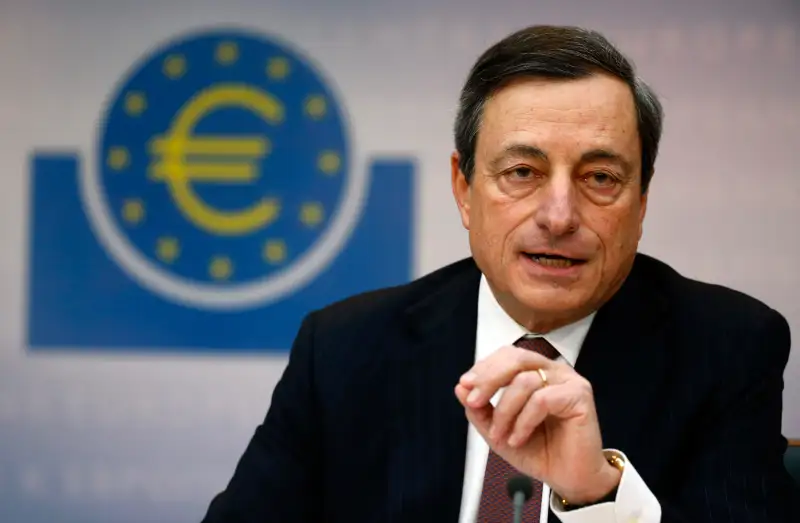Europe's Central Bank Is Paying Negative Interest Rates. What Does That Mean?
Money is not a client of any investment adviser featured on this page. The information provided on this page is for educational purposes only and is not intended as investment advice. Money does not offer advisory services.

At least we're not Europe.
While Americans are starting to shift their attention to the next economic war -- against inflation, as Money's Pat Regnier notes -- European policymakers are still frantically trying to fight the last one against deflation.
Toward that end, the European Central Bank on Thursday took the extraordinary step of going negative — that is, it cut the interest rate that it offers banks for holding excess reserves from 0% to -0.10%. It was part of a broader stimulus plan that also included a cut in another key European benchmark rate from 0.25% to 0.15%.
The extreme measures indicate just how worried European policymakers are about the threat of deflation.
But how do negative interest rates actually work?
Well, banks in the region will now be punished for keeping excess reserves at the ECB rather than deploying that money in the economy.
In the U.S., for instance, our central bank — the Federal Reserve — pays banks 0.25% on excess reserves that they keep on deposit. (In turn, banks pay you interest for parking your money in their CDs and money market accounts). By contrast, European banks who want to deposit their excess reserves will now be dinged 0.10%.
The move is designed to encourage banks to deploy their excess cash by investing it and loaning it out to spur economic growth, rather than just sitting on it.
Maybe encourage isn't the right word. As David Kotok, chief investment officer at Cumberland Advisors, described it last year: Negative rates "employ only a stick and no carrot. Their use tends to progress from disincentive through penalty to punishment."
What is the European Central Bank's real goal?
ECB president Mario Draghi took this radical step in hopes of accomplishing a few things in the short term:
1) Weaken the euro. By lowering its rates just as the U.S. Fed Reserve is debating when to start raising rates, the ECB is trying to send a loud signal to the global currency markets. The message: Don't park your cash in our currency. That message was received loud and clear, as the euro has weakened in recent weeks in anticipation of Draghi's moves.
Euro to US Dollar Exchange Rate data by YCharts
You can debate whether it's good in the long run for a country (or in this case, region) to promote a weak currency. However, in the short run, a falling euro would help European exporters compete on price with their U.S. and Asian counterparts.
2) Promote borrowing and investment by European companies. By prodding banks to deploy their capital while simultaneously lowering other interest rates, Draghi wants to juice economic activity by making it cheap and attractive for European companies to borrow funds. At least more attractive than their American competitors are finding. This is important as the U.S. recovery is on much firmer footing than Europe's.
Eurozone Industrial Production data by YCharts
3) Introduce more inflation to the region. Right now, the year-over-year inflation rate in the Eurozone has slipped below 1%, which is well below the near-2% goal that the ECB is targeting. Isn't low inflation good? Yes, but a growing economy needs some inflation, and deflation is distinctly bad. If Europe were to slip into deflation, it would be that much harder for the region's companies and consumers to pay down their debt.
Eurozone Inflation Rate data by YCharts
What could go wrong?
A lot of things. Obviously, there could be unintended consequences of such a move. For instance if banks don't feel it is safe to put this capital to work, a -0.10% rate may not be punitive enough to persuade them to free up capital in a meaningful way. At the same time, the punishment may be steep enough for banks to start raising fees and rates on their customers, which would actually curtail economic activity.
Also, what happens if banks go beyond what the ECB wants and start making investments that are too risky, threatening the economy in another way?
Critics of negative interest rate policies point out that the problem with Europe's economy isn't necessarily the lack of supply of investment capital. There's simply a demand problem in an economy where GDP is essentially flat.
How radical an idea is this?
This isn't the first time that a central bank has deployed negative rates, but it's the first time that a central bank this big and important has done so in such a calculated way.
Two years ago, for instance, Denmark tried negative rates on CDs to keep foreign investors from driving up the value of its currency. Switzerland tried something similar in the 1970s.
In fact, in the aftermath of the financial crisis, academics publicly debated whether the Fed should deploy a similar strategy to promote growth here at home.
During the depths of the crisis in 2009, Greg Mankiw, a key economic adviser to President George W. Bush, argued in this New York Times piece that then Fed chairman Ben Bernanke should try out negative rates to get the U.S. economy out of recession then.
A year later, Alan Blinder, former vice chairman of the Fed and a key economic adviser to President Bill Clinton, backed negative rates specifically on Fed-held excess reserves in the Wall Street Journal.
Ultimately, the Fed turned to another out-of-the-box idea — direct bond purchases in the open market, as part of so-called quantitative easing — to promote growth.
Still, negative rates proved to be one of the few ideas that economists on both side of the political aisle embraced in the crisis.
How radical is that?